Development and Investigation of Task Sharing with IoT and Computing
VerifiedAdded on 2022/11/18
|7
|1420
|454
Project
AI Summary
This project investigates task sharing methodologies using task computing and the Internet of Things (IoT), particularly within construction environments. The research defines IoT, explores existing task recommendation tools, and introduces the CONSTASK framework, a task-sharing methodology designed for construction sites. The study employs a verification and validation methodology, detailing activities like requirement review, code verification, and various testing methods (smoke, regression, functional, and system testing). The implementation phase focuses on developing the framework, transitioning from development to production. Evaluation methods include surveys, interviews, and other techniques like observation and user diaries to assess the framework's usability and effectiveness, with the ultimate goal of improving task management and content delivery via mobile devices within a smart environment.
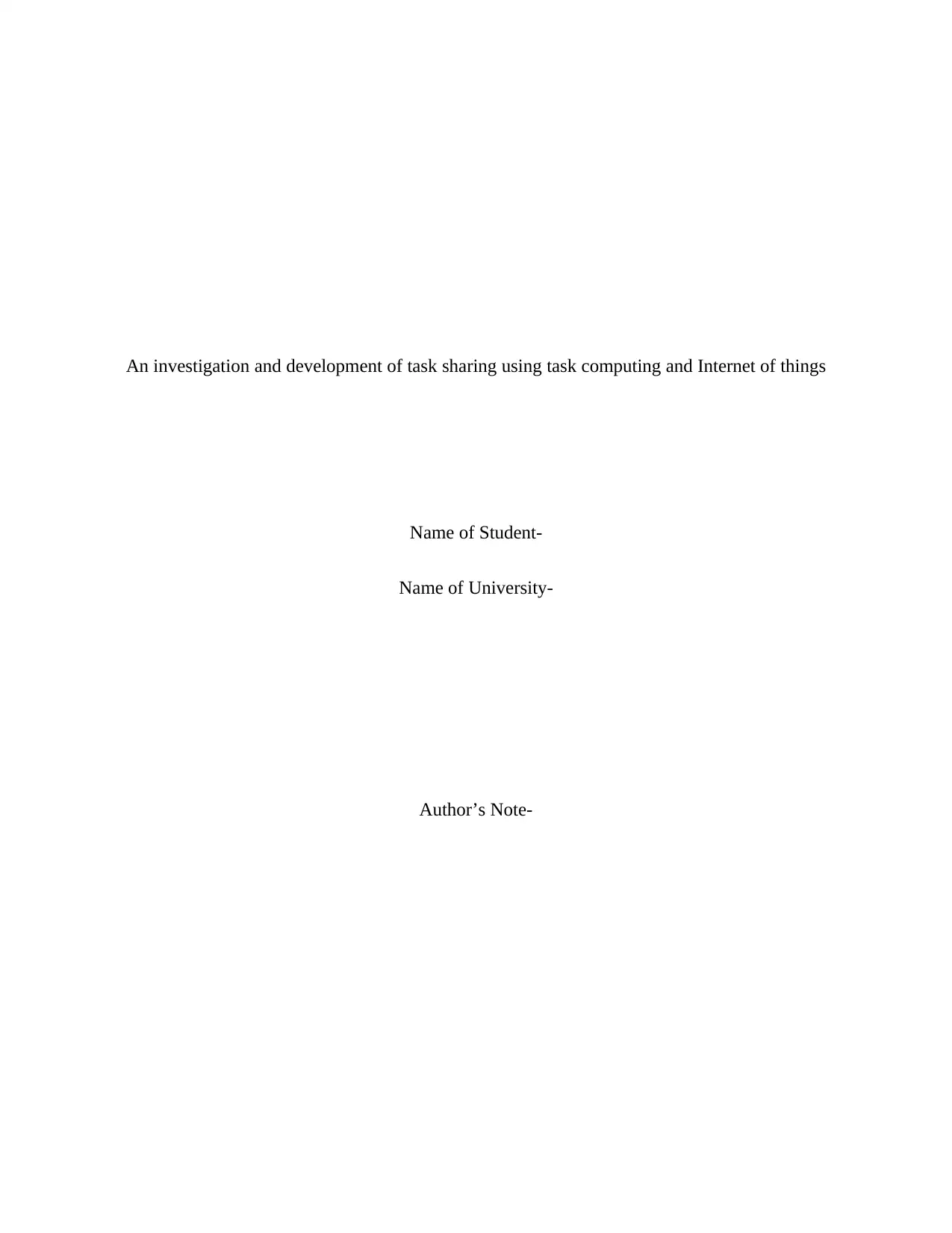
An investigation and development of task sharing using task computing and Internet of things
Name of Student-
Name of University-
Author’s Note-
Name of Student-
Name of University-
Author’s Note-
Paraphrase This Document
Need a fresh take? Get an instant paraphrase of this document with our AI Paraphraser
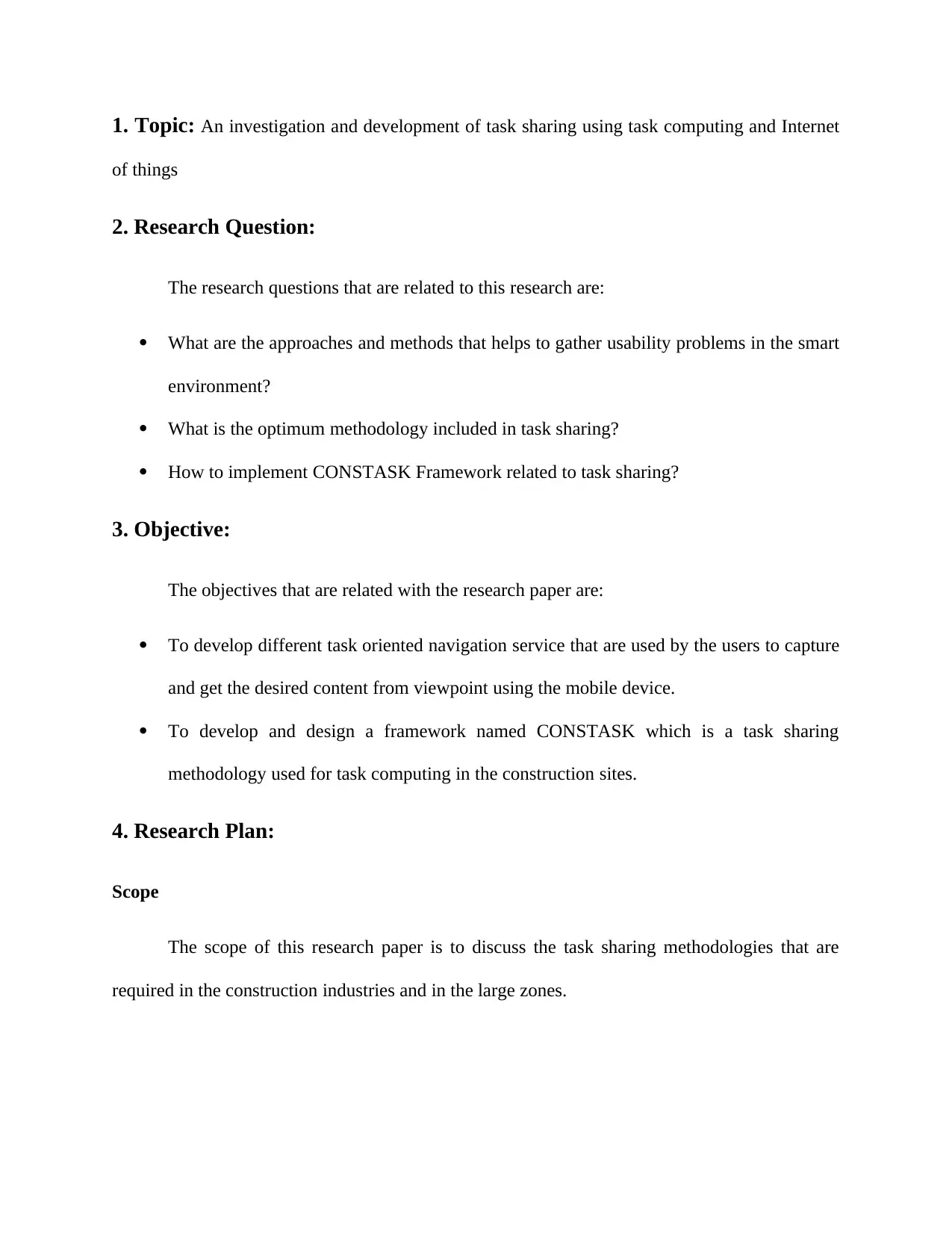
1. Topic: An investigation and development of task sharing using task computing and Internet
of things
2. Research Question:
The research questions that are related to this research are:
What are the approaches and methods that helps to gather usability problems in the smart
environment?
What is the optimum methodology included in task sharing?
How to implement CONSTASK Framework related to task sharing?
3. Objective:
The objectives that are related with the research paper are:
To develop different task oriented navigation service that are used by the users to capture
and get the desired content from viewpoint using the mobile device.
To develop and design a framework named CONSTASK which is a task sharing
methodology used for task computing in the construction sites.
4. Research Plan:
Scope
The scope of this research paper is to discuss the task sharing methodologies that are
required in the construction industries and in the large zones.
of things
2. Research Question:
The research questions that are related to this research are:
What are the approaches and methods that helps to gather usability problems in the smart
environment?
What is the optimum methodology included in task sharing?
How to implement CONSTASK Framework related to task sharing?
3. Objective:
The objectives that are related with the research paper are:
To develop different task oriented navigation service that are used by the users to capture
and get the desired content from viewpoint using the mobile device.
To develop and design a framework named CONSTASK which is a task sharing
methodology used for task computing in the construction sites.
4. Research Plan:
Scope
The scope of this research paper is to discuss the task sharing methodologies that are
required in the construction industries and in the large zones.
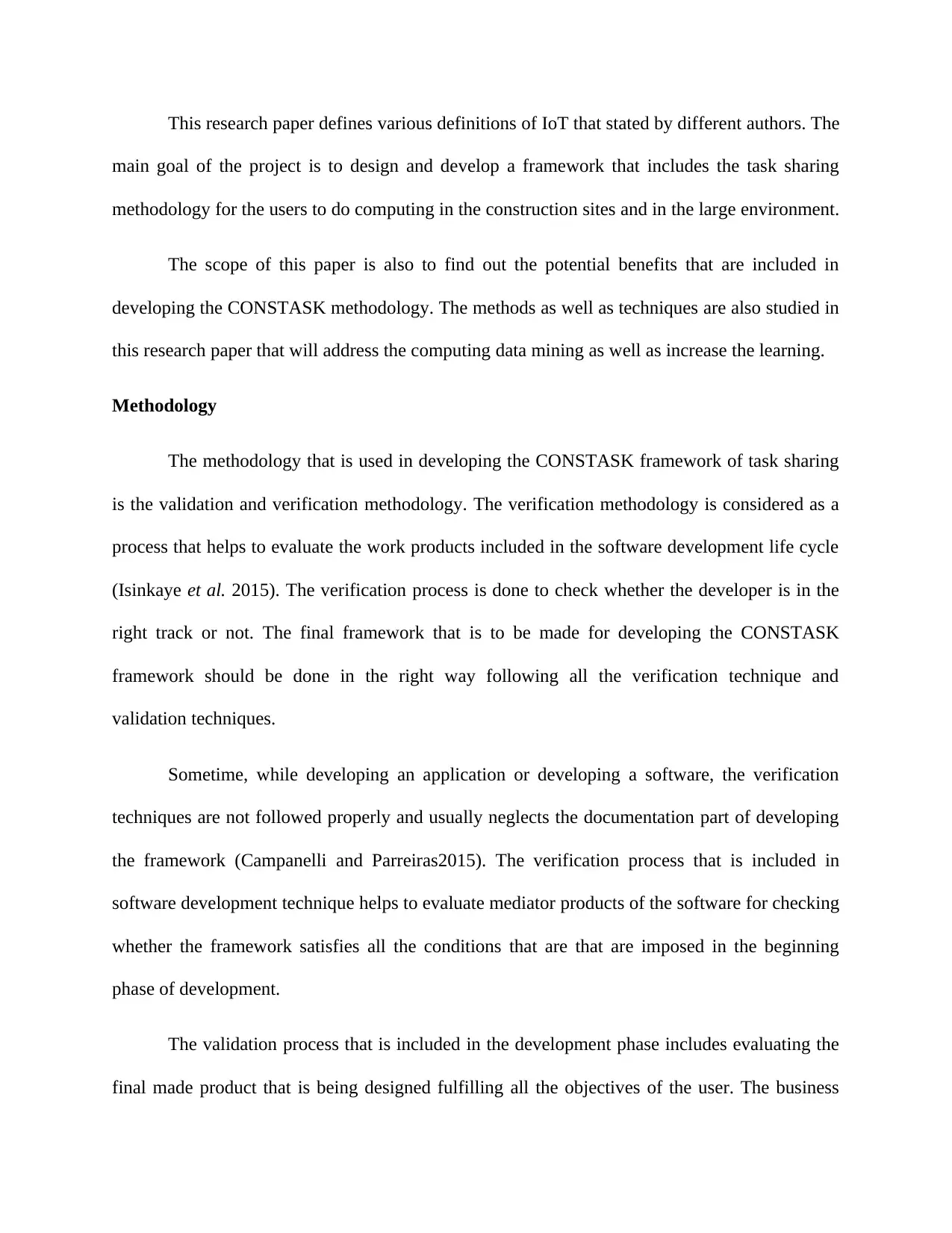
This research paper defines various definitions of IoT that stated by different authors. The
main goal of the project is to design and develop a framework that includes the task sharing
methodology for the users to do computing in the construction sites and in the large environment.
The scope of this paper is also to find out the potential benefits that are included in
developing the CONSTASK methodology. The methods as well as techniques are also studied in
this research paper that will address the computing data mining as well as increase the learning.
Methodology
The methodology that is used in developing the CONSTASK framework of task sharing
is the validation and verification methodology. The verification methodology is considered as a
process that helps to evaluate the work products included in the software development life cycle
(Isinkaye et al. 2015). The verification process is done to check whether the developer is in the
right track or not. The final framework that is to be made for developing the CONSTASK
framework should be done in the right way following all the verification technique and
validation techniques.
Sometime, while developing an application or developing a software, the verification
techniques are not followed properly and usually neglects the documentation part of developing
the framework (Campanelli and Parreiras2015). The verification process that is included in
software development technique helps to evaluate mediator products of the software for checking
whether the framework satisfies all the conditions that are that are imposed in the beginning
phase of development.
The validation process that is included in the development phase includes evaluating the
final made product that is being designed fulfilling all the objectives of the user. The business
main goal of the project is to design and develop a framework that includes the task sharing
methodology for the users to do computing in the construction sites and in the large environment.
The scope of this paper is also to find out the potential benefits that are included in
developing the CONSTASK methodology. The methods as well as techniques are also studied in
this research paper that will address the computing data mining as well as increase the learning.
Methodology
The methodology that is used in developing the CONSTASK framework of task sharing
is the validation and verification methodology. The verification methodology is considered as a
process that helps to evaluate the work products included in the software development life cycle
(Isinkaye et al. 2015). The verification process is done to check whether the developer is in the
right track or not. The final framework that is to be made for developing the CONSTASK
framework should be done in the right way following all the verification technique and
validation techniques.
Sometime, while developing an application or developing a software, the verification
techniques are not followed properly and usually neglects the documentation part of developing
the framework (Campanelli and Parreiras2015). The verification process that is included in
software development technique helps to evaluate mediator products of the software for checking
whether the framework satisfies all the conditions that are that are imposed in the beginning
phase of development.
The validation process that is included in the development phase includes evaluating the
final made product that is being designed fulfilling all the objectives of the user. The business
⊘ This is a preview!⊘
Do you want full access?
Subscribe today to unlock all pages.

Trusted by 1+ million students worldwide
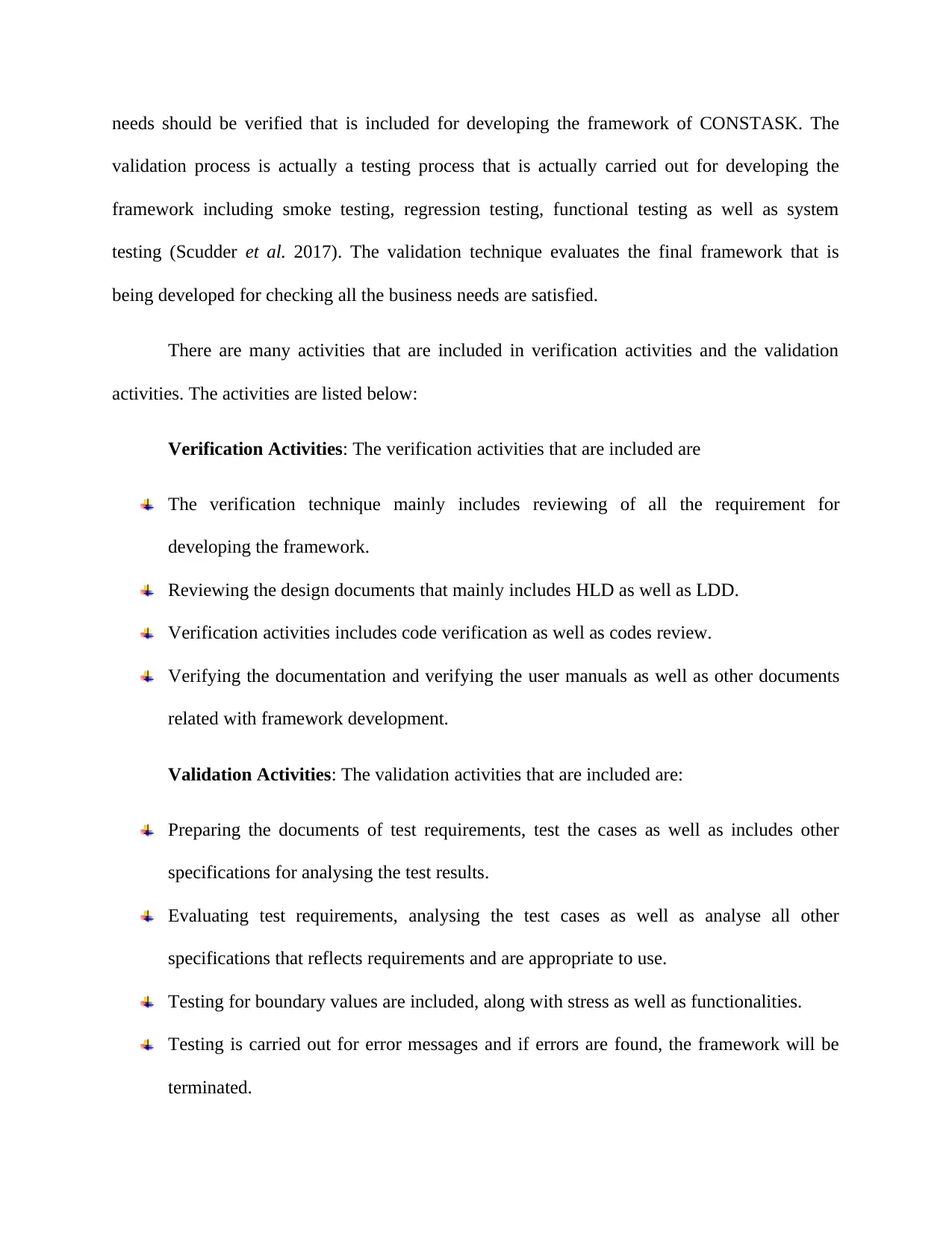
needs should be verified that is included for developing the framework of CONSTASK. The
validation process is actually a testing process that is actually carried out for developing the
framework including smoke testing, regression testing, functional testing as well as system
testing (Scudder et al. 2017). The validation technique evaluates the final framework that is
being developed for checking all the business needs are satisfied.
There are many activities that are included in verification activities and the validation
activities. The activities are listed below:
Verification Activities: The verification activities that are included are
The verification technique mainly includes reviewing of all the requirement for
developing the framework.
Reviewing the design documents that mainly includes HLD as well as LDD.
Verification activities includes code verification as well as codes review.
Verifying the documentation and verifying the user manuals as well as other documents
related with framework development.
Validation Activities: The validation activities that are included are:
Preparing the documents of test requirements, test the cases as well as includes other
specifications for analysing the test results.
Evaluating test requirements, analysing the test cases as well as analyse all other
specifications that reflects requirements and are appropriate to use.
Testing for boundary values are included, along with stress as well as functionalities.
Testing is carried out for error messages and if errors are found, the framework will be
terminated.
validation process is actually a testing process that is actually carried out for developing the
framework including smoke testing, regression testing, functional testing as well as system
testing (Scudder et al. 2017). The validation technique evaluates the final framework that is
being developed for checking all the business needs are satisfied.
There are many activities that are included in verification activities and the validation
activities. The activities are listed below:
Verification Activities: The verification activities that are included are
The verification technique mainly includes reviewing of all the requirement for
developing the framework.
Reviewing the design documents that mainly includes HLD as well as LDD.
Verification activities includes code verification as well as codes review.
Verifying the documentation and verifying the user manuals as well as other documents
related with framework development.
Validation Activities: The validation activities that are included are:
Preparing the documents of test requirements, test the cases as well as includes other
specifications for analysing the test results.
Evaluating test requirements, analysing the test cases as well as analyse all other
specifications that reflects requirements and are appropriate to use.
Testing for boundary values are included, along with stress as well as functionalities.
Testing is carried out for error messages and if errors are found, the framework will be
terminated.
Paraphrase This Document
Need a fresh take? Get an instant paraphrase of this document with our AI Paraphraser
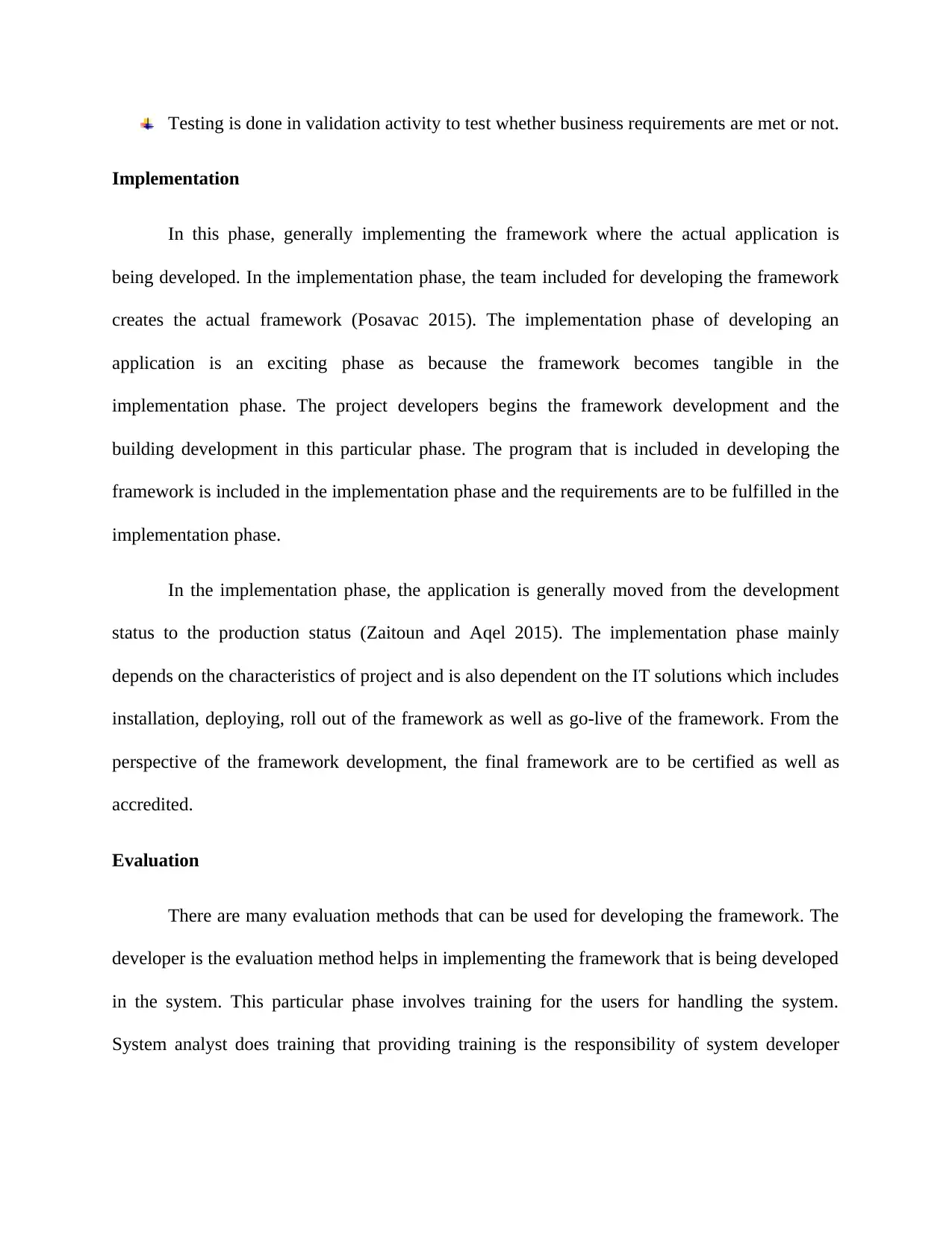
Testing is done in validation activity to test whether business requirements are met or not.
Implementation
In this phase, generally implementing the framework where the actual application is
being developed. In the implementation phase, the team included for developing the framework
creates the actual framework (Posavac 2015). The implementation phase of developing an
application is an exciting phase as because the framework becomes tangible in the
implementation phase. The project developers begins the framework development and the
building development in this particular phase. The program that is included in developing the
framework is included in the implementation phase and the requirements are to be fulfilled in the
implementation phase.
In the implementation phase, the application is generally moved from the development
status to the production status (Zaitoun and Aqel 2015). The implementation phase mainly
depends on the characteristics of project and is also dependent on the IT solutions which includes
installation, deploying, roll out of the framework as well as go-live of the framework. From the
perspective of the framework development, the final framework are to be certified as well as
accredited.
Evaluation
There are many evaluation methods that can be used for developing the framework. The
developer is the evaluation method helps in implementing the framework that is being developed
in the system. This particular phase involves training for the users for handling the system.
System analyst does training that providing training is the responsibility of system developer
Implementation
In this phase, generally implementing the framework where the actual application is
being developed. In the implementation phase, the team included for developing the framework
creates the actual framework (Posavac 2015). The implementation phase of developing an
application is an exciting phase as because the framework becomes tangible in the
implementation phase. The project developers begins the framework development and the
building development in this particular phase. The program that is included in developing the
framework is included in the implementation phase and the requirements are to be fulfilled in the
implementation phase.
In the implementation phase, the application is generally moved from the development
status to the production status (Zaitoun and Aqel 2015). The implementation phase mainly
depends on the characteristics of project and is also dependent on the IT solutions which includes
installation, deploying, roll out of the framework as well as go-live of the framework. From the
perspective of the framework development, the final framework are to be certified as well as
accredited.
Evaluation
There are many evaluation methods that can be used for developing the framework. The
developer is the evaluation method helps in implementing the framework that is being developed
in the system. This particular phase involves training for the users for handling the system.
System analyst does training that providing training is the responsibility of system developer
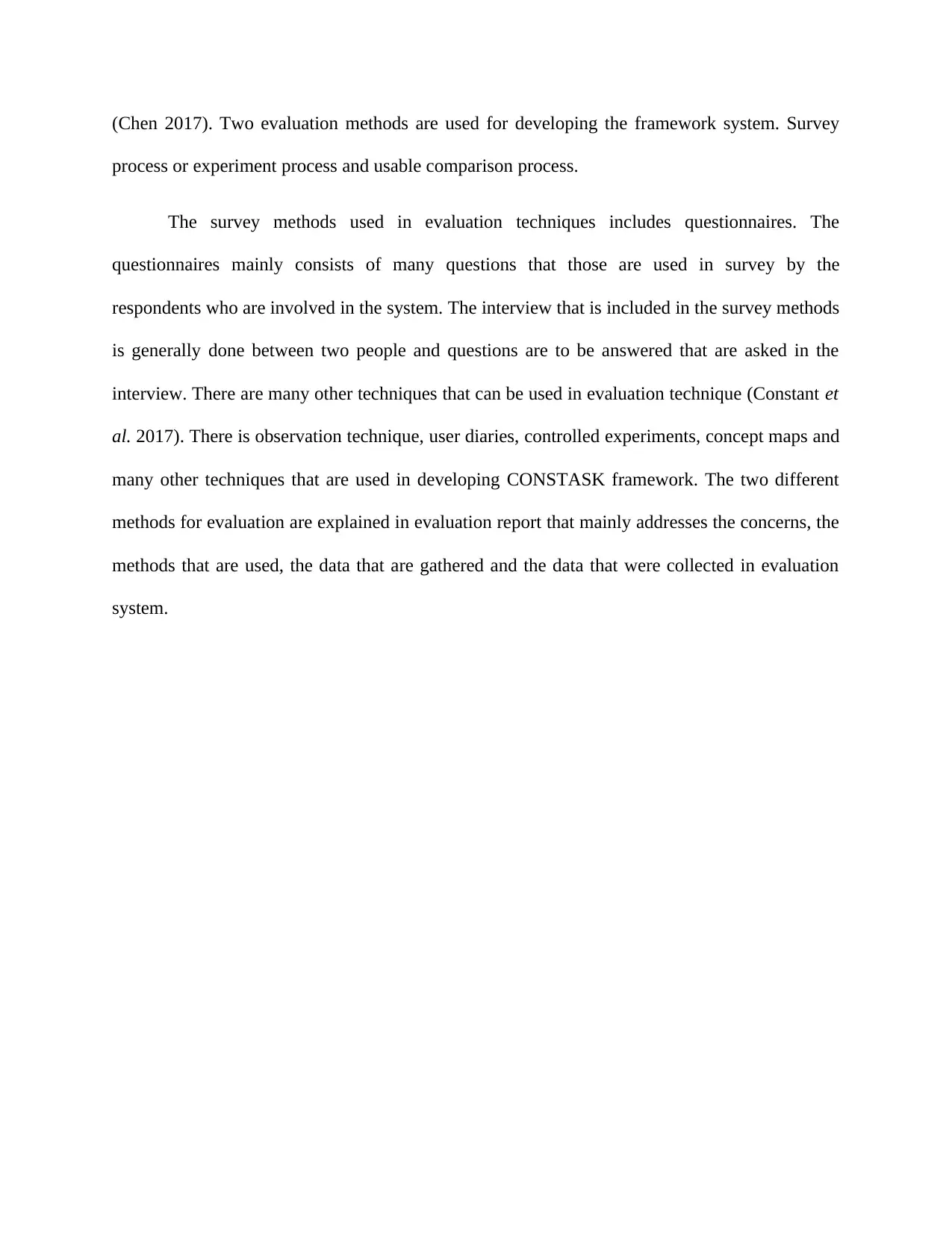
(Chen 2017). Two evaluation methods are used for developing the framework system. Survey
process or experiment process and usable comparison process.
The survey methods used in evaluation techniques includes questionnaires. The
questionnaires mainly consists of many questions that those are used in survey by the
respondents who are involved in the system. The interview that is included in the survey methods
is generally done between two people and questions are to be answered that are asked in the
interview. There are many other techniques that can be used in evaluation technique (Constant et
al. 2017). There is observation technique, user diaries, controlled experiments, concept maps and
many other techniques that are used in developing CONSTASK framework. The two different
methods for evaluation are explained in evaluation report that mainly addresses the concerns, the
methods that are used, the data that are gathered and the data that were collected in evaluation
system.
process or experiment process and usable comparison process.
The survey methods used in evaluation techniques includes questionnaires. The
questionnaires mainly consists of many questions that those are used in survey by the
respondents who are involved in the system. The interview that is included in the survey methods
is generally done between two people and questions are to be answered that are asked in the
interview. There are many other techniques that can be used in evaluation technique (Constant et
al. 2017). There is observation technique, user diaries, controlled experiments, concept maps and
many other techniques that are used in developing CONSTASK framework. The two different
methods for evaluation are explained in evaluation report that mainly addresses the concerns, the
methods that are used, the data that are gathered and the data that were collected in evaluation
system.
⊘ This is a preview!⊘
Do you want full access?
Subscribe today to unlock all pages.

Trusted by 1+ million students worldwide
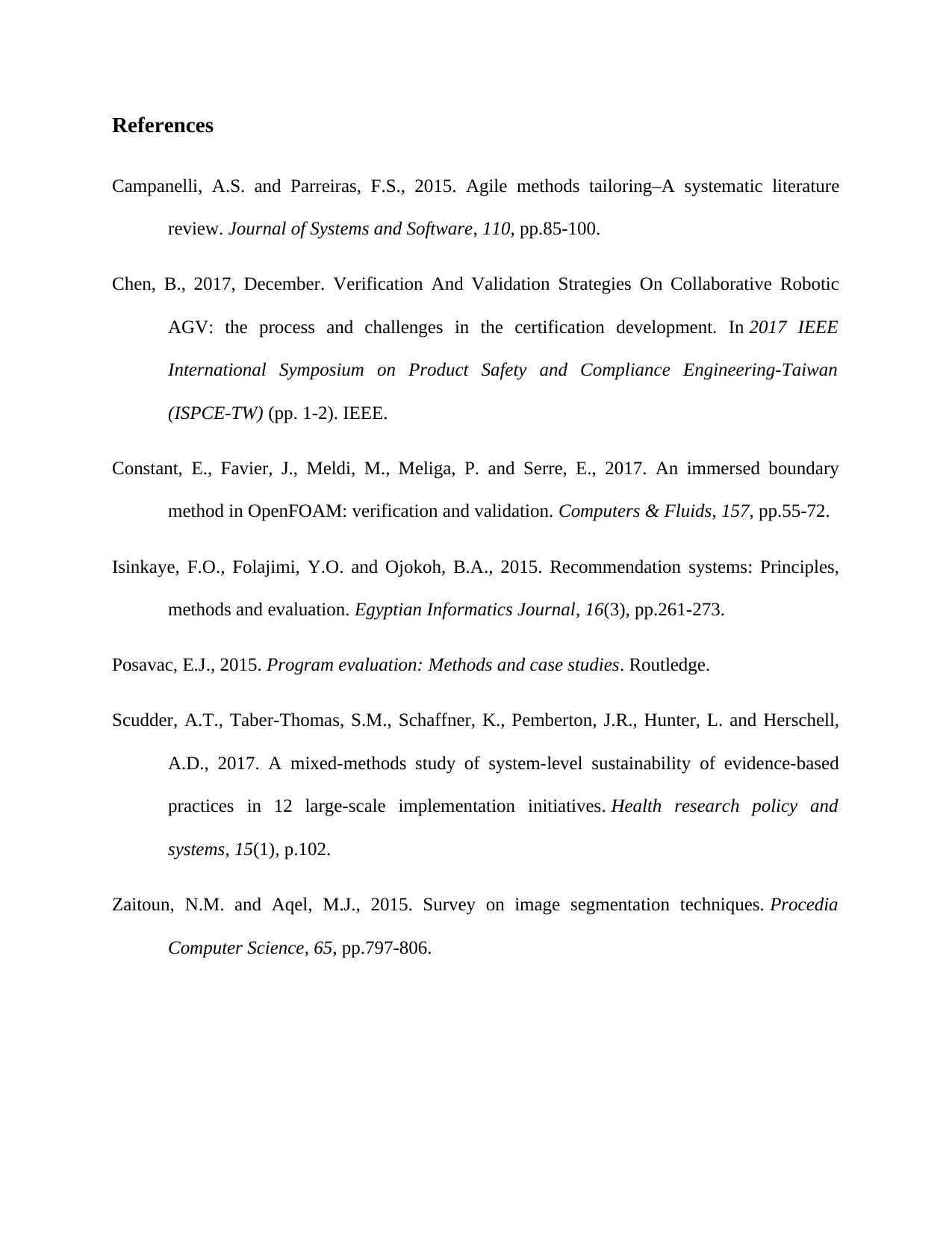
References
Campanelli, A.S. and Parreiras, F.S., 2015. Agile methods tailoring–A systematic literature
review. Journal of Systems and Software, 110, pp.85-100.
Chen, B., 2017, December. Verification And Validation Strategies On Collaborative Robotic
AGV: the process and challenges in the certification development. In 2017 IEEE
International Symposium on Product Safety and Compliance Engineering-Taiwan
(ISPCE-TW) (pp. 1-2). IEEE.
Constant, E., Favier, J., Meldi, M., Meliga, P. and Serre, E., 2017. An immersed boundary
method in OpenFOAM: verification and validation. Computers & Fluids, 157, pp.55-72.
Isinkaye, F.O., Folajimi, Y.O. and Ojokoh, B.A., 2015. Recommendation systems: Principles,
methods and evaluation. Egyptian Informatics Journal, 16(3), pp.261-273.
Posavac, E.J., 2015. Program evaluation: Methods and case studies. Routledge.
Scudder, A.T., Taber-Thomas, S.M., Schaffner, K., Pemberton, J.R., Hunter, L. and Herschell,
A.D., 2017. A mixed-methods study of system-level sustainability of evidence-based
practices in 12 large-scale implementation initiatives. Health research policy and
systems, 15(1), p.102.
Zaitoun, N.M. and Aqel, M.J., 2015. Survey on image segmentation techniques. Procedia
Computer Science, 65, pp.797-806.
Campanelli, A.S. and Parreiras, F.S., 2015. Agile methods tailoring–A systematic literature
review. Journal of Systems and Software, 110, pp.85-100.
Chen, B., 2017, December. Verification And Validation Strategies On Collaborative Robotic
AGV: the process and challenges in the certification development. In 2017 IEEE
International Symposium on Product Safety and Compliance Engineering-Taiwan
(ISPCE-TW) (pp. 1-2). IEEE.
Constant, E., Favier, J., Meldi, M., Meliga, P. and Serre, E., 2017. An immersed boundary
method in OpenFOAM: verification and validation. Computers & Fluids, 157, pp.55-72.
Isinkaye, F.O., Folajimi, Y.O. and Ojokoh, B.A., 2015. Recommendation systems: Principles,
methods and evaluation. Egyptian Informatics Journal, 16(3), pp.261-273.
Posavac, E.J., 2015. Program evaluation: Methods and case studies. Routledge.
Scudder, A.T., Taber-Thomas, S.M., Schaffner, K., Pemberton, J.R., Hunter, L. and Herschell,
A.D., 2017. A mixed-methods study of system-level sustainability of evidence-based
practices in 12 large-scale implementation initiatives. Health research policy and
systems, 15(1), p.102.
Zaitoun, N.M. and Aqel, M.J., 2015. Survey on image segmentation techniques. Procedia
Computer Science, 65, pp.797-806.
1 out of 7
Related Documents
Your All-in-One AI-Powered Toolkit for Academic Success.
+13062052269
info@desklib.com
Available 24*7 on WhatsApp / Email
![[object Object]](/_next/static/media/star-bottom.7253800d.svg)
Unlock your academic potential
Copyright © 2020–2025 A2Z Services. All Rights Reserved. Developed and managed by ZUCOL.





